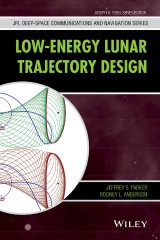Details

Low-Energy Lunar Trajectory Design
JPL Deep-Space Communications and Navigation Series 1. Aufl.
|
138,99 € |
|
| Verlag: | Wiley |
| Format: | |
| Veröffentl.: | 18.06.2014 |
| ISBN/EAN: | 9781118854976 |
| Sprache: | englisch |
| Anzahl Seiten: | 448 |
DRM-geschütztes eBook, Sie benötigen z.B. Adobe Digital Editions und eine Adobe ID zum Lesen.
Beschreibungen
<p>Based on years of research conducted at the NASA Jet Propulsion Laboratory, <i>Low-Energy Lunar Trajectory Design</i> provides high-level information to mission managers and detailed information to mission designers about low-energy transfers between Earth and the moon. The book answers high-level questions about the availability and performance of such transfers in any given month and year. Low-energy lunar transfers are compared with various other types of transfers, and placed within the context of historical missions.</p> <p>Using this book, designers may reconstruct any transfer described therein, as well as design similar transfers with particular design parameters.</p> <p>An Appendix, “Locating the Lagrange Points,” and a useful list of terms and constants completes this technical reference.</p> <ul> <li>Surveys thousands of possible trajectories that may be used to transfer spacecraft between Earth and the moon, including transfers to lunar libration orbits, low lunar orbits, and the lunar surface</li> <li>Provides information about the methods, models, and tools used to design low-energy lunar transfers</li> <li>Includes discussion about the variations of these transfers from one month to the next, and the important operational aspects of implementing a low-energy lunar transfer</li> <li>Additional discussions address navigation, station-keeping, and spacecraft systems issues</li> </ul>
<p>Foreword xi</p> <p>Preface xiii</p> <p>Acknowledgments xv</p> <p>Authors xxi</p> <p><b>1 Introduction and Executive Summary 1</b></p> <p>1.1 Purpose 1</p> <p>1.2 Organization 1</p> <p>1.3 Executive Summary 2</p> <p>1.4 Backgound 11</p> <p>1.5 The Lunar Transfer Problem 12</p> <p>1.6 Historical Missions 14</p> <p>1.7 Low-Energy Lunar Transfers 23</p> <p><b>2 Methodology 27</b></p> <p>2.1 Methodology Introduction 27</p> <p>2.2 Physical Data 28</p> <p>2.3 Time Systems 29</p> <p>2.4 Coordinate Frames 32</p> <p>2.5 Models 35</p> <p>2.6 Low-Energy Mission Design 41</p> <p>2.7 Tools 114</p> <p><b>3 Transfers to Lunar Libration Orbits 117</b></p> <p>3.1 Executive Summary 117</p> <p>3.2 Introducuton 120</p> <p>3.3 Direct Transfers Between Earth and Lunar Libration Orbits 122</p> <p>3.4 Low-Energy Transfers Between Earth and Lunar Libration Orbits 161</p> <p>3.5 Three-Body Orbit Transfers 221</p> <p><b>4 Transfers to Low Lunar Orbits 227</b></p> <p>4.1 Executive Summary 227</p> <p>4.2 Introduction 229</p> <p>4.3 Direct Transfers Between Earth and Low Lunar Orbit 231</p> <p>4.4 Low-Energy Transfers Between Earth and Low Lunar Orbit 233</p> <p>4.5 Transfers Between Lunar Libration Orbits and Low Lunar Orbits 258</p> <p>4.6 Transfers Between Low Lunar Orbits and the Lunar Surface 258</p> <p><b>5 Transfers to the Lunar Surface 263</b></p> <p>5.1 Executive Summary 263</p> <p>5.2 Introduction for Transfers to the Lunar Surface 265</p> <p>5.3 Methodology 267</p> <p>5.4 Analysis of Planar Transfers between the Earth and the Lunar Surface 268</p> <p>5.5 Low-Energy Spatial Transfers Between the Earth and the Lunar Surface 277</p> <p>5.6 Transfers Between Lunar Libration Orbits and the Lunar Surface 294</p> <p>5.7 Transfers Between Low Lunar Orbits and the Lunar Surface 298</p> <p>5.8 Conclusions Regardingh Transfers to the Lunar Surface 298</p> <p><b>6 Operations 299</b></p> <p>6.1 Operations Executive Summary 299</p> <p>6.2 Operations Introduction 300</p> <p>6.3 Launch Sites 301</p> <p>6.4 Launch Vehicles 301</p> <p>6.5 Designing a Launch Period 304</p> <p>6.6 Navigation 332</p> <p>6.7 Spacecraft Systems Design 349</p> <p>Appendix A: Locating the Lagrange Points 351</p> <p>References 359</p>
<p><b>Jeffrey S. Parker, Ph.D., </b>was a member of the technical staff at the Jet Propulsion Laboratory (JPL) from 2008 to 2012. Currently Dr. Parker is an Assistant Professor of Astrodynamics at CU-Boulder. His research interests are focused on astrodynamics, space exploration, and autonomous spacecraft operations.<b><br /><br />Rodney L. Anderson</b>, Ph.D., is a member of the JPL technical staff, where he is involved in mission design and navigation and develops new methods for trajectory design. His research interests are focused on the application of dynamical systems theory to astrodynamics and mission design.</p>
<p>Based on years of research conducted at the NASA Jet Propulsion Laboratory, <i>Low-Energy Lunar Trajectory Design</i> provides high-level information to mission managers and detailed information to mission designers about low-energy transfers between Earth and the moon. The book answers high-level questions about the availability and performance of such transfers in any given month and year. Low-energy lunar transfers are compared with various other types of transfers, and placed within the context of historical missions.</p> <p>Using this book, designers may reconstruct any transfer described therein, as well as design similar transfers with particular design parameters.</p> <p>An Appendix, “Locating the Lagrange Points,” and a useful list of terms and constants completes this technical reference.</p>
Diese Produkte könnten Sie auch interessieren:

Turbulent Drag Reduction by Surfactant Additives

von: Feng-Chen Li, Bo Yu, Jin-Jia Wei, Yasuo Kawaguchi

156,99 €

Turbulent Drag Reduction by Surfactant Additives

von: Feng-Chen Li, Bo Yu, Jin-Jia Wei, Yasuo Kawaguchi

156,99 €














